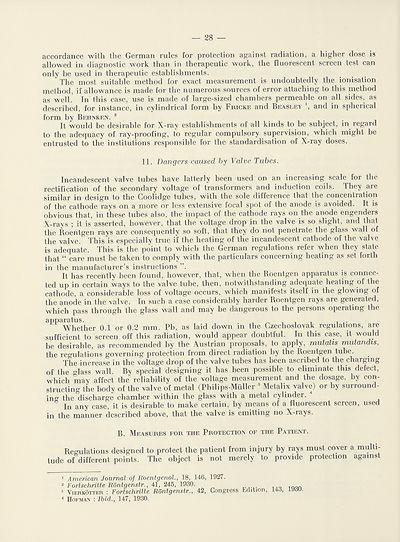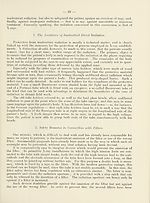Health > Protective measures against dangers resulting from the use of radium, roentgen and ultra-violet rays
(30)
Download files
Complete book:
Individual page:
Thumbnail gallery: Grid view | List view

— 28 —
accordance with the German rules for protection against radiation, a higher dose is
allowed in diagnostic work than in therapeutic work, the fluorescent screen test can
only be used in therapeutic establishments.
The most suitable method for exact measurement is undoubtedly the ionisation
method, if allowance is made for the numerous sources of error attaching to this method
as well. In this case, use is made of large-sized chambers permeable on all sides, as
described, for instance, in cylindrical form by Fricke and Beasley \ and in spherical
form by Behnken. 1 2
It would be desirable for X-ray establishments of all kinds to he subject, in regard
to the adequacy of ray-proofing, to regular compulsory supervision, which might be
entrusted to the institutions responsible for the standardisation of X-ray doses.
11. Dangers caused by Valve Tubes.
Incandescent valve tubes have latterly been used on an increasing scale for the
rectification of the secondary voltage of transformers and induction coils. They are
similar in design to the Coolidge tubes, with the sole difference that the concentration
of the cathode rays on a more or less extensive focal spot of the anode is avoided. It is
obvious that, in these tubes also, the impact of the cathode rays on the anode engenders
X-rays ; it is asserted, however, that the voltage drop in the valve is so slight, and that
the Boentgen rays are consequently so soft, that they do not penetrate the glass wall of
the valve. This is especially true if the heating of the incandescent cathode of the valve
is adequate. This is the point to which the German regulations refer when they state
that “ care must he taken to comply with the particulars concerning heating as set forth
in the manufacturer’s instructions ”.
It has recently been found, however, that, when the Roentgen apparatus is connec¬
ted up in certain ways to the valve tube, then, notwithstanding adequate heating of the
cathode, a considerable loss of voltage occurs, which manifests itself in the glowing of
the anode in the valve. In such a case considerably harder Roentgen rays are generated,
which pass through the glass wall and may be dangerous to the persons operating tie
Whether 0.1 or 0.2 mm. Pb, as laid down in the Czechoslovak regulations, are
sufficient to screen off this radiation, would appear doubtful. In this case, it would
be desirable, as recommended by the Austrian proposals, to apply, mutatis mutandis,
the regulations governing protection from direct radiation by the Roentgen tube.
The increase in the voltage drop of the valve tubes has been ascribed to the charging
of the glass wall. By special designing it has been possible to eliminate this defect,
which may affect the reliability of the voltage measurement and the dosage, by con¬
structing the body of the valve of metal (Philips-Muller 3 4 Metalix valve) or by surround¬
ing the discharge chamber within the glass with a metal cylinder.
In any case, it is desirable to make certain, by means of a fluorescent screen, used
in the manner described above, that the valve is emitting no X-rays.
B. Measures for the Protection of the Patient.
Regulations designed to protect the patient from injury by rays must cover a multi¬
tude of different points. The object is not merely to provide protection against
1 American Journal of Roentgenol., 18, 146, 1927.
2 Fortschritte Rontgenstr., 41, 245, 1930. ,Q
3 Vierkotter i Fortschritte Rontgenstr., 42, Congress Ldition, 143,
4 Hofman : Ibid., 147, 1930.
1930.
accordance with the German rules for protection against radiation, a higher dose is
allowed in diagnostic work than in therapeutic work, the fluorescent screen test can
only be used in therapeutic establishments.
The most suitable method for exact measurement is undoubtedly the ionisation
method, if allowance is made for the numerous sources of error attaching to this method
as well. In this case, use is made of large-sized chambers permeable on all sides, as
described, for instance, in cylindrical form by Fricke and Beasley \ and in spherical
form by Behnken. 1 2
It would be desirable for X-ray establishments of all kinds to he subject, in regard
to the adequacy of ray-proofing, to regular compulsory supervision, which might be
entrusted to the institutions responsible for the standardisation of X-ray doses.
11. Dangers caused by Valve Tubes.
Incandescent valve tubes have latterly been used on an increasing scale for the
rectification of the secondary voltage of transformers and induction coils. They are
similar in design to the Coolidge tubes, with the sole difference that the concentration
of the cathode rays on a more or less extensive focal spot of the anode is avoided. It is
obvious that, in these tubes also, the impact of the cathode rays on the anode engenders
X-rays ; it is asserted, however, that the voltage drop in the valve is so slight, and that
the Boentgen rays are consequently so soft, that they do not penetrate the glass wall of
the valve. This is especially true if the heating of the incandescent cathode of the valve
is adequate. This is the point to which the German regulations refer when they state
that “ care must he taken to comply with the particulars concerning heating as set forth
in the manufacturer’s instructions ”.
It has recently been found, however, that, when the Roentgen apparatus is connec¬
ted up in certain ways to the valve tube, then, notwithstanding adequate heating of the
cathode, a considerable loss of voltage occurs, which manifests itself in the glowing of
the anode in the valve. In such a case considerably harder Roentgen rays are generated,
which pass through the glass wall and may be dangerous to the persons operating tie
Whether 0.1 or 0.2 mm. Pb, as laid down in the Czechoslovak regulations, are
sufficient to screen off this radiation, would appear doubtful. In this case, it would
be desirable, as recommended by the Austrian proposals, to apply, mutatis mutandis,
the regulations governing protection from direct radiation by the Roentgen tube.
The increase in the voltage drop of the valve tubes has been ascribed to the charging
of the glass wall. By special designing it has been possible to eliminate this defect,
which may affect the reliability of the voltage measurement and the dosage, by con¬
structing the body of the valve of metal (Philips-Muller 3 4 Metalix valve) or by surround¬
ing the discharge chamber within the glass with a metal cylinder.
In any case, it is desirable to make certain, by means of a fluorescent screen, used
in the manner described above, that the valve is emitting no X-rays.
B. Measures for the Protection of the Patient.
Regulations designed to protect the patient from injury by rays must cover a multi¬
tude of different points. The object is not merely to provide protection against
1 American Journal of Roentgenol., 18, 146, 1927.
2 Fortschritte Rontgenstr., 41, 245, 1930. ,Q
3 Vierkotter i Fortschritte Rontgenstr., 42, Congress Ldition, 143,
4 Hofman : Ibid., 147, 1930.
1930.
Set display mode to:
![]() Universal Viewer |
Universal Viewer | ![]() Mirador |
Large image | Transcription
Mirador |
Large image | Transcription
Images and transcriptions on this page, including medium image downloads, may be used under the Creative Commons Attribution 4.0 International Licence unless otherwise stated. ![]()
| League of Nations > Health > Protective measures against dangers resulting from the use of radium, roentgen and ultra-violet rays > (30) |
|---|
| Permanent URL | https://digital.nls.uk/191800576 |
|---|
| Shelfmark | LN.III |
|---|---|
| Description | Over 1,200 documents from the non-political organs of the League of Nations that dealt with health, disarmament, economic and financial matters for the duration of the League (1919-1945). Also online are statistical bulletins, essential facts, and an overview of the League by the first Secretary General, Sir Eric Drummond. These items are part of the Official Publications collection at the National Library of Scotland. |
|---|---|
| Additional NLS resources: |
|

